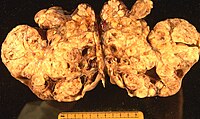
Photo from wikipedia
Borderline ovarian tumors represent a heterogeneous group of tumors with a specific noninvasive histology, a low malignant potential, and an uncertain outcome. They have a low incidence, occurring at younger… Click to show full abstract
Borderline ovarian tumors represent a heterogeneous group of tumors with a specific noninvasive histology, a low malignant potential, and an uncertain outcome. They have a low incidence, occurring at younger age and diagnosed in early stages, and are associated with infertility, and they have a better prognosis when compared with epithelial ovarian cancer. We retrospectively evaluated all the patients with the diagnosis of borderline ovarian tumors who underwent surgical treatment between January 1, 2013, and December 31, 2016, in Filantropia Clinical Hospital. In the study, were included 50 patients with borderline ovarian tumors with an average age of 52. Thirty-four patients (68%) were postmenopausal and 16 (32%) were premenopausal. We found 44 unilateral tumors (88%) and 6 bilateral (12%), and the size varied between 3 and 40 cm. Regarding the histopathological examination, we found 34 patients with borderline ovarian tumors of serous type (68%), 12 of mucinous type (24%), and 4 (8%) other types. We had 2 cases of extraovarian extension, one to peritoneal surface and one to the appendix. Surgical treatment was radical in 38 cases and conservative in 12 cases. The management of borderline ovarian tumors should first consider the oncologic safety but will be well balanced with less radical treatment in selected cases. The various clinical and histological aspects of BOT should guide the surgeon and the oncologist to take the best decisions for the patient in order to be as radical as it is necessary.
Journal Title: Indian Journal of Surgery
Year Published: 2020
Link to full text (if available)
Share on Social Media: Sign Up to like & get
recommendations!